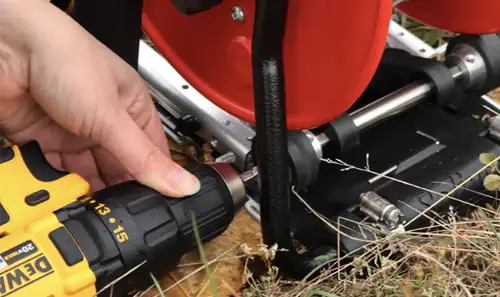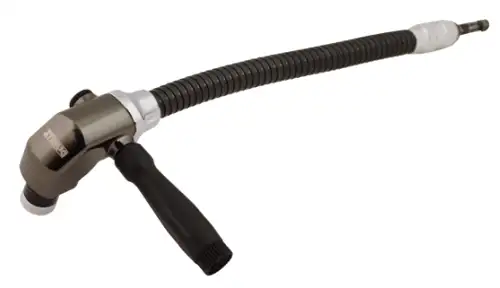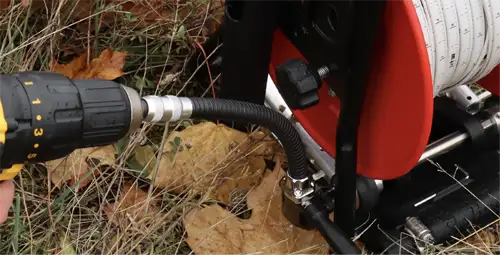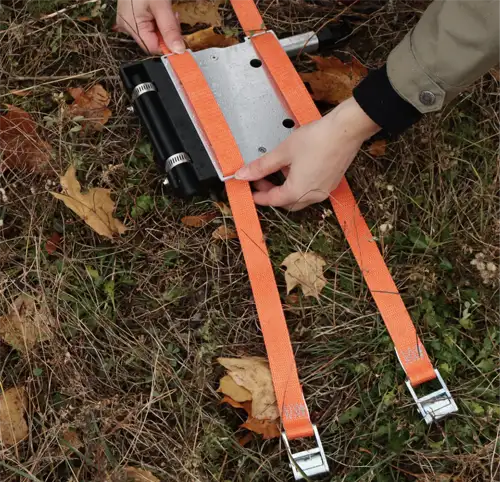- A power drill/driver is used to connect to the standard 1/4" hex fitting on the roller drive shaft of the Power Winder. Follow the directions specific to your drill/driver for attachment to the hex fitting.
- Ensure to adjust the drill to an appropriate speed.
- Position the reel as required for your specific measurement application. Ensure the brake is not applied to the reel.
- With the drill set in "reverse", slowly start the drill, which will engage the rollers and start the reel turning, unwinding and lowering the tape/cable/tubing on the reel. You may need to engage the brake against the reel to slow the winding speed.
- Once at depth, stop the drill and operate the Water Level Meter or other connected instrument as described in their separate instructions to obtain the desired measurement or sample.
- When ready, switch the drill to the "forward" position and start the drill (if at depths >200 m (650 ft) start the drill at a slower speed and increase as you wind). This will turn the reel in the opposite direction to wind the tape/cable/ or tubing back up. Note: you can use your free hand to properly guide the tape back onto the reel.
- Once finished, stop the drill and remove it from the Power Winder Fitting.
Note:
It is recommended to use a drill/driver with a minimum of 12V, however 18V is preferred.

Note:
Setting your drill to a slower speed can allow more precise measurements of product layers or temperature or conductivity interfaces when using instruments such as the Solinst Model 122 Interface Meter or Model 107 TLC Meter.
Note:
It is recommended to place medium and large reels on the ground, or on a sturdy surface like a Solinst Field Table. When using small reels, there is the option to hang the reel using the Tape Guide, or using optional straps available from Solinst to secure the Power Winder and reel directly to a well casing.
Note:
When using a Water Level Meter or Tag Line, ensure you slow the drill/winding as the probe/tag nears the surface, so as to not get hit with the probe/tag as it exits the well.
Using the Optional Flex Drill Adaptor (#116199)
For easier access to the 1/4" hex fitting on the Power Winder, a Flex Drill Adaptor is available so you can operate the Power Winder using your drill/driver at any angle.

- To connect the Adaptor, push the collar fitting forward and slide onto the Power Winder hex fitting and release.
- Connect your drill/driver to 1/4" hex fitting on the other end of the Adaptor, and operate as described in the previous section. Remove the drill from the Adaptor when finished.
- To remove the Adaptor, pull the collar fitting back and slide off the hex fitting on the Power Winder.

Using the Optional Cinch Straps (#116059)
A set of cinch straps is available for adding to the base of the Power Winder, to allow you to secure the Power Winder to a well casing or for use in another application.

- To connect the cinch straps, thread them through the base of the Power Winder as shown in the photo above.
- To use the straps, insert the end of the strap into the backside of the buckle and push it through the buckle lever. Pull the strap to tighten it.
- To release the straps, push down on the lever of the buckle and pull the strap through.
Power Winder Periodic Maintenance
The 3/32" Allen key that is supplied with the Power Winder should be used to tighten all of the fasteners on the Power Winder that could become loose over time. This includes the set screws in the rollers, the four set screws on the swing arm and the fasteners on the base of the Power Winder. No lubrication is used, anywhere.


